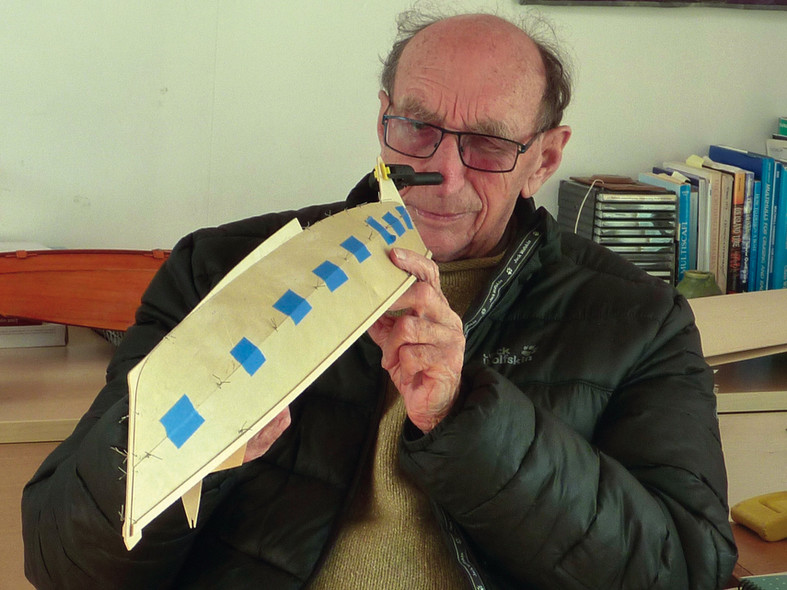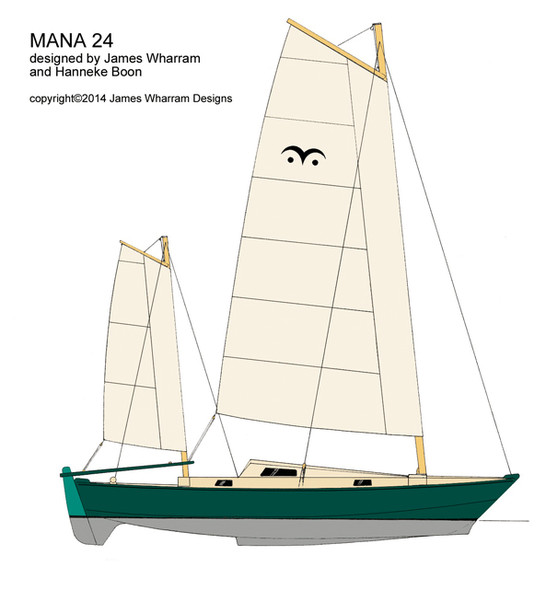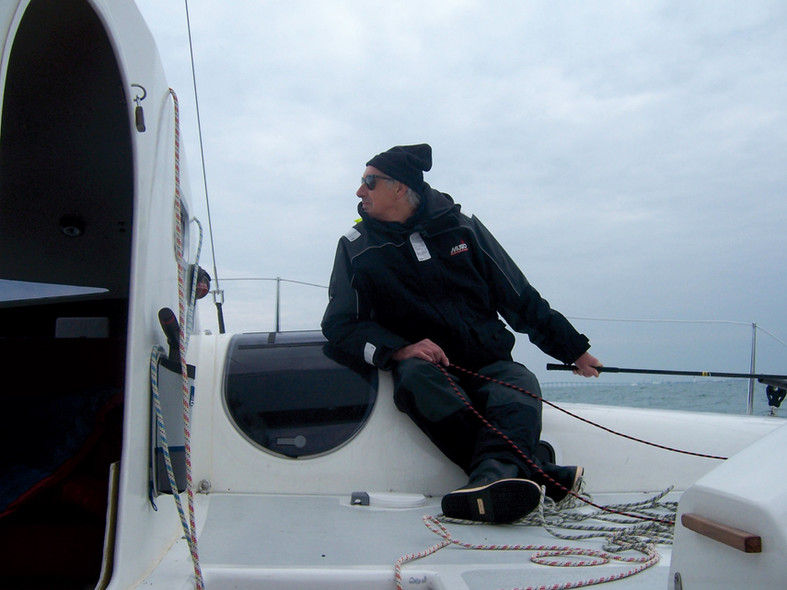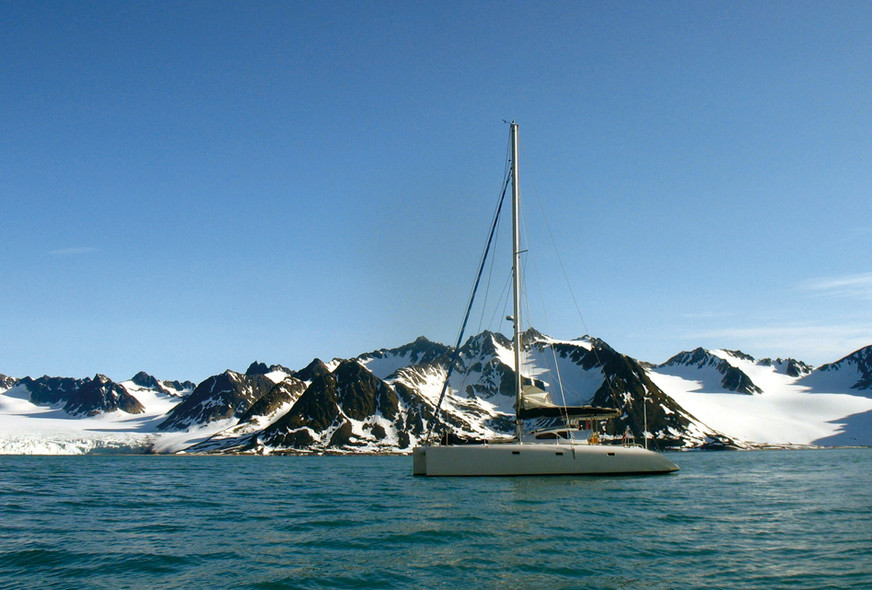
Issue #: 142
Published: July / August 2015
- Price per issue - digital : 5.40€Digital magazine
- Access to Multihulls World digital archives Digital archives
James Wharram was born in 1928, in Manchester, UK. This celestial adventurer opened the way to roaming the oceans in a multihull, and was the first sailor to cross the Atlantic with the Tangaroa catamaran he had built himself. He has become one of the most prolific architects in the world and an important figure in leisure sailing on more than one hull. His designs (now in co-creation with Hanneke Boon) are inspired directly by Polynesian designs, artistically reinterpreted.
Inspired by the French sailor Eric de Bisschop, I became a pioneer of catamaran design. Like Eric de Bisschop my early voyages in the 1950s were driven by a wish to prove that the Pacific double canoe was a seaworthy vessel, capable of crossing oceans. My first catamaran designs were based on studies in museums and libraries, making me one of the early experimental marine archaeologists.
Watercraft is one of Man’s earliest artefacts. Early Man migrated to the far reaches of the world via the coasts and rivers. Man first reached Australia more than 50,000 years ago. He must have done so by watercraft because there was always a substantial water gap between what is now Indonesia and Australia, a gap no other mammal managed to cross. Watercraft and living on and by the sea is therefor part of our genetic make-up, or in Jungian psychology, it is one of the ‘arch-types of our sub-conscious’. It explains modern Man’s attraction to the sea, swimming and sailing. We design boats to fulfil this sub-conscious need by not only supplying a boat design, but also encouraging - through design - a lifestyle suitable for sea living, using simplicity as its basis. This allows people to get in touch with the archaic Sea Nomad in their subconscious. Designing in this way requires a strong design discipline. The aim for simplicity leads us to look for the most appropriate, cost-effective building materials. Since the early 1980s we have developed the use of wood/epoxy/glass into a simple system, which we have constantly improved on. Using this system we have designed a whole range of wood/epoxy catamarans, from 17ft – 65 ft, all keeping to the strict discipline of simplicity and keeping cost low, while achieving all the needs of a fast, elegant, safe, STABLE, seagoing design.
These are the design disciplines we consistently adhere to:
- traditional sailing ship hull proportions, i.e. modest freeboard, never higher than 13%. This keeps windage to the minimum, requiring minimum driving force (i.e. sailarea and engine power)
- slim hulls of around 12:1 or slimmer to reduce wave drag, to achieve speed without the need for excessive rigs,
- high stability, achieved through low rig proportions, so the boat will always look after the crew, not the other way around
- flexible hull joining, allowing the boat to flow over the seas, reducing stresses on the structure and increasing durability.
Keeping boat weight low is an advantage in an unballasted, form-stable catamaran, as it increases load carrying capacity, essential for a cruising catamaran. The latest high tech designers achieve low weight with the use of expensive, exotic materials and highly industrialised building methods. These are not appropriate for the majority of sailors working on a low budget. We achieve low weight by making every piece of cabin furniture also a structural strength element, thereby saving both weight and cost. This way we can use moderate cost, easy to use materials and still achieve the light weights of the high-tech more elaborate designs.To achieve maximum stability and still high speeds we developed a new simple low aspect ratio rig, which we call the Wharram Wingsail Rig, which can be in one-masted or two-masted configuration, keeping C of E low. This rig combines efficient aerodynamics with great simplicity and moderate cost due to the minimum use of expensive hardware. It predates the high-tech square headed sail rigs seen on most of the recently designed multihulls by nearly 20 years.
Present day multihulls are strongly influenced by modern styling, following the same trends as car and luxury hotel design. They are often based on previous generation multihulls with new styling and popular modern features added, without ever going back to basic design principles. Hence we see higher and higher freeboard to accommodate all the urban luxury needs of modern Man, as well as higher and higher rigs to achieve the urge to go faster than others in this ‘competitive world’. Higher freeboards mean higher windage and hence a need for larger rigs and larger engines, leading to higher weight, leading to fatter hulls, leading again to larger engines, rigs etc. etc.
However my concern is the latest trend in expensive luxury fast cruising cats that achieve speed through very large rigs modelled on racing multihulls, with aspect ratios of 150% LOA. We are seriously concerned about the stability of these catamarans. They are often shown with one hull lifted clear of the water, sailing on the edge of capsize (remember that once the windward hull is lifted clear of the water the righting moment decreases very rapidly on a catamaran). Film footage of one of these designs nominated for Sail Magazine’s prestigious “Best Boat 2013” award, shows her sailing with the windward hull kissing the surface in winds of just 12-18 knots! It should always be remembered that multihulls are FORM-STABLE vessels with a very long history. I have taken my design inspiration from the fantastic ancient boats of the Pacific that made long ocean voyages before any other type of vessel. This is a heritage we modern designers must be proud of and not abuse by forcing it to conform to our luxury, urban, competitive Western demands.
You can read all about our design principles (Stability, Wharram Wingsail rig, Freeboard heights, Heavy weather performance etc.
Eric Lerouge has been designing, sailing and thinking multihulls since 1976. He is one of the most well-known French architects and also a passionate believer in popularizing multihulls; he is at the origin of countless fast, modern creations. Ville Audrain was, in 1984, the first big production catamaran exhibited at the Grand Pavois Boat Show in La Rochelle. His designs, sometimes avant-garde (Petter 50, Maia 147) are efficient, seaworthy and reliable. A large number of Lerouge-designed boats are today sailing the oceans.
A fascinating question in relation to sustainable development! Progress must be defined as an improvement on what exists, and not creating new products at any cost. Every era has created masterpieces which corresponded to the techniques available. I have sailed on a replica of a Viking ship; designed by great sailors, we were quite comfortable aboard and the harmony of the lines is perfect - but it wouldn’t cross my mind to build one of those hulls in polyester! Closer to home, the Tornado, which gave me the catamaran bug, was a brilliant example of the use of plywood, yet a C Class catamaran has much more developed lines, thanks to composites. Over the forty years I have been designing multihulls, I have been able to confirm the benefits of the techniques coming from the competition world. Without them there would be no roller furlers, no self tailing winches, no autopilots, no stretch-free halyards... On my first ‘Ville Audrain’, the fittings were rather ‘agricultural’. The main traveler, on rollers, didn’t move under tension – not too good from a safety point of view, that! During the refits of my first designs, I was able to appreciate the gain provided by these new techniques. There is a whole world of difference between a Freydis from the 90s, with an aluminum mast and Dacron sails, and the same boat rigged with a carbon mast, a square-headed Spectra mainsail and textile shrouds. One of my favorite cats is the Azuli. Fast, seaworthy, reliable and aesthetically pleasing. Yet the very latest Windbliss 110, the same size, will offer comparable performance, with a galley and headroom in the saloon, greater load-carrying capacity, two inboard engines and a semi-rigid on the davits. Not bad? It’s the gain allowed by progress. Silent, reliable wind generators, high-performance solar panels, powerful hydro-alternators, longer lasting, lighter batteries allow total self-sufficiency to be envisaged, free of mechanical constraints. We can always build boats in wood, as it is renewable, but without epoxy, wood isn’t durable, and I am not ready to sacrifice months of sailing to repaint and revarnish. Ecology is above all about the product’s durability, its reduced maintenance. In this field, we have not done better than the current infused constructions. What does leisure sailing hold in store for us in the future? We can use new techniques on traditional boats, but from my point of view, this would be lacking in taste and a waste. The basis of ecology is not to throw away or waste; it is better to keep our valiant ancestors sailing than to plagiarize them in new constructions. The future will oblige us to be more mature in our real needs, and it’s here that our nautical preoccupations join the issues in society. Each technical advance opens new doors in naval architecture. Concepts which we had trouble making successful are becoming possible. The major challenge will without a doubt be the rig. Although the Bermudan sloop offers good efficiency, it is probably at the end of its development. Even with electric winches, a mainsail of over 100m² is a brute to handle. The America’s Cup has demonstrated that wings are more efficient and easier to maneuver, with less effort. All that remains is to make them useable, with the possibility of reducing their area and furling them. With lift coefficients double those of traditional sails, safety will improve, as enormous rigs will no longer be necessary for satisfactory performance, and the fibers will allow us to manufacture light, unstayed masts.
You mustn’t confuse modernism and progress, and technology must be used judiciously, without looking to create something new at any price. Marketing principles lead us to think that boats only sail in good weather, so it is useless to deal with bad weather! However the sea doesn’t change, the waves are still just as high. The growing trend for inverted bows is understandable on a sport cat, whose trim is adjusted by the movements of the crew; their usefulness on an ocean cruiser can be questioned! Under bare poles in the Bay of Biscay, the bottom line is the longitudinal stability curve. The wind doesn’t change, its density remains the same, and sailing to windward in a fresh breeze is still a punishment! You must however be able to beat off a hostile coast or cut short the unpleasantness, and the engine is not a solution; too uncomfortable in these conditions. The laws of aerodynamics don’t change, the stronger the wind, the more the windage of the superstructure is a handicap, with respect to the power of a reefed sail. On the other hand, it doesn’t upset me to see the owner of a 60-footer enjoying himself with one hull in the air, if he has the means to pay for his mistakes! And what if the boat of the future were a return to the roots, simpler, closer to nature, more reasonably priced? I had so much fun in my youth aboard the family Iroquois, that I think it might be time to use some real industrial means to bring the cruising cat within everyone’s reach. Naval architecture remains a constant arbitrage between the contradictory demands of the specifications: comfort, performance, safety, aesthetics, economics, and we have to take into the panoply the avant-garde solutions which bring a genuine plus to the project, and be wary of others, which are just fads or gadgets.




What readers think
Post a comment
No comments to show.